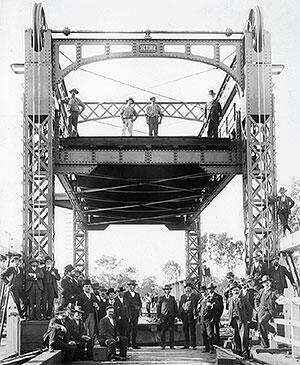
Movable Span Bridge Study
The Movable Span Bridge Study will play a vital role in assessing and managing heritage movable span bridges into the future.
Executive summary
The Movable Span Bridge Study has been completed by GHD in conjunction with the Environment Branch of the Transport for NSW (TfNSW).
The study will play a vital role in assisting TfNSW in assessing and managing their heritage movable span bridges into the future.
TfNSW currently manages 26 movable span bridges in NSW, of which 14 are still operational. Between 1802 and 2005 there were five distinct types of movable bridge types built which included:
- pontoon
- vertical lift
- bascule
- swing
- sliding spans.
In total 66 movable span bridges were constructed in NSW, of which the majority (48) were of the vertical lift or bascule type, but many of these have now been demolished or are permanently closed.
This study documents the:
- overarching history and individual past of the vertical lift span bridges
- bascule bridges
- the sole remaining TfNSW swing bridge in NSW
- the only table bridge in Australia.
The study provides extensive research and background information utilising numerous documents and sources to establish each bridges history, engineering authenticity and enables their engineering heritage significance to be evaluated and assessed.
The detailed historical research into the development of movable span bridges in Europe and America has enabled a better appreciation of the influences that affected the design of the 48 vertical lift span and bascule bridges built in NSW between 1882 and 2005.
Through comparative analysis of the lifting mechanisms of these bridges it has been possible to develop a classification system that identifies each of these bridges as belonging to one of 13 subtypes; 8 for vertical lift span and 5 for bascule bridges. The first 6 vertical lift span subtypes identified by this study can be properly recognised as Australian adaptations with no international equivalent.
This classification provides a better understanding of the performance and shortcomings of those movable span bridges that are still operational as these issues appear common to all bridges within a type. Another benefit of this classification is that it enables the standardisation of maintenance strategies across each type and the development of more consistent heritage and conservation management practices.
Lastly, we have provided and outlined maintenance, repair, rehabilitation and upgrade capacity strategies to ensure each movable span bridge types continued safe use into the future.
Download
- Volume 1: Vertical Lift Span Bridges (PDF, 30.02 MB)
- Volume 1: Vertical Lift Span Bridges (PDF, 57.69 MB)
- Volume 1: Vertical Lift Span Bridges (PDF, 40.05 MB)
- Volume 2: Bascule and Swing Span Bridges (PDF, 58.38 MB)
- Volume 2: Bascule and Swing Span Bridges (PDF, 28.1 MB)
- Appendices (PDF, 1.2 MB)
